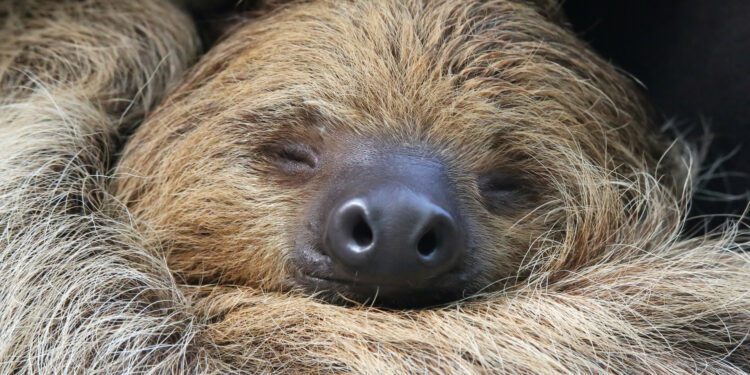Sloths, the famously slow-moving yet adorable creatures native to Central and South America, could face extinction by the end of the century due to climate change.
Researchers investigating how sloths respond to rising temperatures have found that the animals’ slow metabolism and limited ability to regulate body temperature may leave them unable to survive in a warming world—especially for populations living in high-altitude regions.
“Despite being iconic species, comprehensive long-term population monitoring simply hasn’t been conducted at a scale that reflects the true challenges sloths face,” lead researcher Rebecca Cliffe told Newsweek. “However, from our 15 years of working with sloths in Costa Rica, we are very concerned. In areas where sloths were once abundant, we have observed their populations completely disappear over the past decade.”
The study, published in PeerJ Life & Environment, focused on two-fingered sloths inhabiting both lowland and highland environments in Costa Rica.
By measuring oxygen consumption and core body temperature under simulated climate change conditions, scientists determined how sloths might cope with the projected temperature increases expected by 2100. The results were troubling.
Stock image of a sleeping two-toed sloth. Sloths in high-altitude regions show a sharp increase in their resting metabolic rate as temperatures rise, which may make it difficult for them to consume enough food in…
Stock image of a sleeping two-toed sloth. Sloths in high-altitude regions show a sharp increase in their resting metabolic rate as temperatures rise, which may make it difficult for them to consume enough food in coming years.
More
tane-mahuta/Getty
Sloths in high-altitude regions show a sharp increase in their resting metabolic rate (RMR) as temperatures rise, indicating a heightened energy demand, the study found.
Lowland sloths, on the other hand, were better adapted to warmer climates. Their metabolic strategy involves entering a state of metabolic depression when temperatures exceed their comfort zone, known as the “thermally active zone.”
But this strategy only works up to a point. Both groups face significant challenges if temperatures increase by the projected 2 to 6 C (3.6 to 10.8 F) by 2100.
“Sloths are uniquely vulnerable to rising temperatures due to their physiological adaptations,” Cliffe said. “They survive on an extremely low-calorie diet, so conserving energy is critical for them.
“One key way they do this is by not actively regulating their body temperature like most mammals do—temperature regulation is an energy-intensive process.”
A major concern is that sloths’ slow digestion rates—up to 24 times slower than similar-sized herbivores—make it difficult for them to increase food intake to meet rising metabolic demands.
This slow metabolic rate, combined with their minimal energy-processing capacity, means that sloths cannot easily balance the increased energy requirements brought on by higher temperatures.
Adding to the plight of high-altitude sloths is the fact that these populations have limited ability to migrate to cooler areas, as they are geographically constrained. Unlike lowland sloths, which may be able to shift their ranges to higher altitudes in search of more suitable temperatures, highland sloths are left with few options.
The authors acknowledged that more work is needed to fully understand sloths’ metabolic response to rising temperatures, and with a small sample size, the study leaves room for some uncertainty and error.
Cliffe and her team have also called for further research into adaptive strategies and the development of conservation policies aimed at mitigating the threats posed to one of the Americas’ most iconic mammals.
Ultimately, though, the survival of sloths across Central and South America will depend on how far temperatures rise. “If climate change continues unchecked and these regions become uninhabitable, sloths may not have anywhere else to go,” Cliffe warned.
“Unlike some species, sloths are creatures of habit, highly specialized in their habitat, and are not suitable for translocation to other regions. If their environment becomes too hot, their survival is unlikely.”
Do you have a tip on a science story that Newsweek should be covering? Do you have a question about sloths? Let us know via [email protected].
References
Cliffe, R. N., Ewart, H. E., Scantlebury, D. M., Kennedy, S., Avey-Arroyo, J., Mindich, D., & Wilson, R. P. (2024). Sloth metabolism may make survival untenable under climate change scenarios. PeerJ Life & Environment. https://doi.org/10.7717/peerj.18168
Source link : http://www.bing.com/news/apiclick.aspx?ref=FexRss&aid=&tid=66f6968cb2e745bbabaf2737c455589e&url=https%3A%2F%2Fwww.newsweek.com%2Fsloths-brink-extinction-struggle-adapt-climate-change-1959837&c=956849152580154174&mkt=en-us
Author :
Publish date : 2024-09-27 00:00:00
Copyright for syndicated content belongs to the linked Source.





